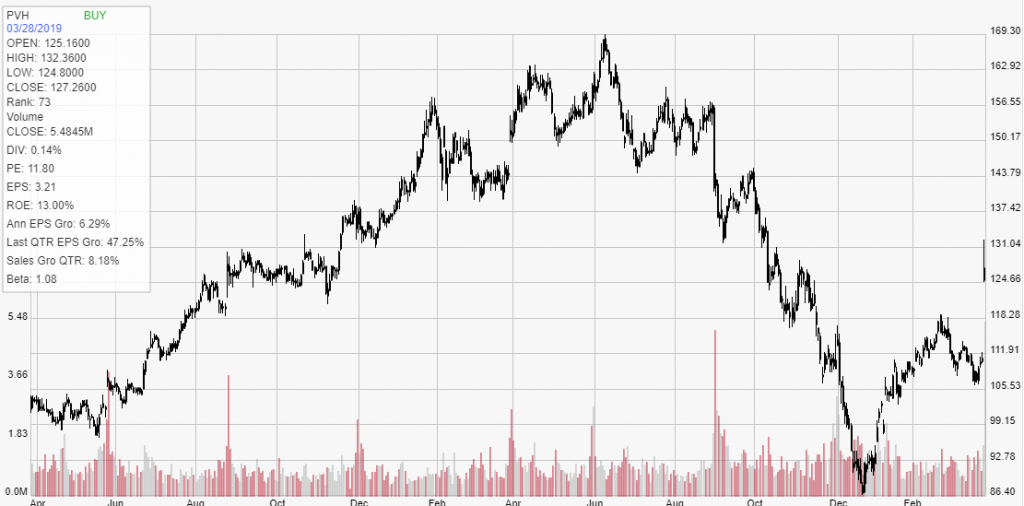PVH Corp. (PVH) released its earnings report for the October-December period, and the financials blew past analyst expectations. The parent company of several high-profile clothing brands like Calvin Klein, Tommy Hilfiger, and Van Heusen beat on the top and bottom lines, galvanizing investors to push the stock to the highest close since October.
Investors have embraced the apparel company in 2019, pushing the stock up double-digits as they rally behind the firm’s strong millennial and Gen-Z appeal. The apparel sector as a whole is on a tear, with stocks like Ralph Lauren Corp. (RL) and Columbia Sportswear Co. (COLM) up 25.1% and 24.6%, respectively this year. That has investors wondering if the apparel sector is currently overheating or at the early stages of a bull run.
Here’s how PVH fared last quarter – and what investors can expect from the company and the overall sector in 2019…
The News
PVH’s earnings per share (EPS) and revenue surpassed Wall Street expectations, but even more impressive was the firm’s full-year 2019 forecast indicating the explosive growth is just getting started.
The company earned $1.84 per share in the fourth quarter, which was up more than 16% year-over-year and beating the expected $1.76 by a strong margin of 4.5%. While revenue fell roughly 0.6% year-over-year from $2.5 billion to $2.48 billion, it still surpassed the $2.41 billion estimate by 2.9%.
As for earnings forecasts, PVH said it expects full-year adjusted EPS to land between $10.30 and $10.40. The upper end of that range is far above Wall Street’s estimate of $10.31, and analysts expect continued strength in the Tommy Hilfiger brand to play a huge role in reaching those lofty profit expectations.
Revenue from Hilfiger items climbed 2% to $1.2 billion in Q4 and increased 12% overall last year. While PVH expects full-year 2019 revenue to rise 4%, it predicts Tommy Hilfiger itself to outpace that with 6% growth. Steven Marotta, an analyst with investment bank C.L. King & Associates, said last quarter was “stellar” due to the fact that “Tommy Hilfiger far outperformed our expectations.”
However, not all PVH brands carried their own weight. For instance, Calvin Klein, the firm’s second-biggest revenue source, saw a 2% sales decline in Q4 due to the brand’s lagging jean sales in North America. It also suffered from higher prices and “fashion forward” products that resulted in customer backlash and underperforming sales during the holiday period.
How Investors Reacted
Shares of PVH rocketed 14.8% on Monday from $110.89 at the previous close to $127.26 to become the S&P 500’s top performer for the day. It marks one of the company’s best one-day performances ever as well as the stock’s best settlement since Oct. 17 when shares closed at $127.96. With Thursday’s gains, PVH is now up 37% this year since closing at $92.95 on Dec. 31.
The Bigger Picture
PVH’s future can’t be understood without taking into context the broader apparel sector, which has been on the up and up this year as several competitors recently reported similarly stellar Q4 earnings.
Lululemon Athletica Inc. (LULU), the apparel and athleisure wear company, just reported better-than-expected earnings on Wednesday that showed year-over-year revenue growth of 26% same-store sales growth of 16%. On Feb. 5, Ralph Lauren posted income of $120 million, a sharp turnaround from the $81.8 million loss reported in Q4 2017. Columbia Sportswear also swung to a profit last quarter, earning $113.3 million after losing $7.1 million during the year-ago period.
The strong financials stem from the marked shift in selling clothes in retail stores to selling them online. Lululemon’s online sales, for instance, posted double-digit growth last quarter, with e-commerce sales in China growing a particularly strong 140%. PVH plans to keep capitalizing on that trend, particularly regarding its standout Tommy Hilfiger brand. The company said it would close its store on New York’s Fifth Avenue, joining Ralph Lauren, Gap Inc. (GPS), and Lord & Taylor in shuttering their flagship locations on Manhattan’s iconic shopping strip.
Accruing more online Hilfiger sales appears to be the primary challenge ahead. Ironically, the less-successful Calvin Klein brand has a strong online presence, while the burgeoning Hilfiger brand lacks in that department. Analysts from Jane Hali & Associates noted Hilfiger clothes still very much rely on outlet sales and that “online, the experience could improve” for the brand. They continued in regard to the Tommy Hilfiger and Calvin Klein brands: “Calvin used to have mobile and it seems to have been removed. Tommy does not have mobile.”
Looking Ahead
As with the apparel sector in general, PVH appears to be in good shape looking ahead. Sales are growing thanks to the rapidly rising wave of fashion-conscious consumers among younger demographics. But the struggle for PVH is the same as the struggle for the entire retail sector: shifting focus to online sales to enhance convenience and cut the overhead costs associated with keeping an outlet store’s lights on.
That being said, investors should consider adding PVH to their portfolio as a long-term play. It poses as just one of several opportunities to ride the apparel sector’s current bull market to higher profits down the road. The fact that PVH also happens to hold the strong Hilfiger brand serves as an added bonus.
